Algerian Food offers a captivating culinary adventure, and at larosafoods.com, we’re thrilled to guide you through its rich tapestry of flavors. From hearty stews to delicate pastries, explore must-try Algerian cuisine, celebrate its diverse influences, and discover authentic recipes, cooking tips, and nutritional insights. Embark on a North African food journey filled with fragrant spices, fresh ingredients, and the joy of culinary exploration.
1. What Defines Traditional Algerian Cuisine?
Traditional Algerian cuisine is a vibrant mosaic woven from the threads of its rich history and diverse cultural influences. Rooted in Arab, Amazigh (Berber), and Turkish culinary traditions, Algerian dishes also reflect the impact of Roman, French, and Spanish settlers. Mutton and poultry are staples, while vegetables and dried fruits add depth and variety. According to culinary experts, the key to understanding Algerian food lies in its blend of indigenous ingredients and techniques with external influences, creating a unique culinary identity.
- Arab and Amazigh (Berber) Influences: These form the foundation of Algerian cuisine, emphasizing hearty stews and the use of spices.
- Turkish Influence: Evident in dishes like bourek and chorba frik, showcasing the legacy of the Ottoman Empire.
- Roman, French, and Spanish Influences: Reflected in the incorporation of certain ingredients and cooking styles, such as the use of tomatoes.
2. What Are Some Must-Try Algerian Dishes?
Algerian cuisine boasts a diverse array of dishes that cater to various tastes and preferences. Here are some essential dishes to try, each offering a unique glimpse into Algeria’s culinary heritage:
| Dish | Description | Key Ingredients |
|---|---|---|
| Chakchouka | A flavorful stew of tomatoes, onions, peppers, and spices, often served with poached eggs and flatbread. | Tomatoes, onions, peppers, eggs, cumin, paprika |
| Couscous | Algeria’s national dish, made from steamed semolina and topped with savory stews or sweetened with milk, almonds, and cinnamon. | Semolina, vegetables, meat (optional), milk, orange blossom water, almonds, cinnamon |
| Rechta | A special-occasion pasta dish featuring thin, flat noodles in a cinnamon-infused chicken sauce. | Flat noodles, chicken, cinnamon, potatoes, turnips, ras el hanout |
| Dobara | A spicy vegetable stew made with chickpeas or fava beans, seasoned with olive oil, tomato paste, and lemon juice. | Chickpeas or fava beans, olive oil, tomato paste, lemon juice, spices |
| Berkoukes | A hearty soup featuring large couscous balls in a spicy tomato broth, often with meat and vegetables. | Large couscous balls, tomatoes, meat (optional), vegetables, spices |
| Chorba Frik | A tomato-based soup made with “frik” (crushed green wheat), often served with flatbread or bourek. | Frik, tomatoes, meat (optional), vegetables, herbs, lemon |
| Harira | A smooth and creamy tomato soup, typically made with lamb, beef, or chicken, and sometimes with frik or vermicelli. | Tomatoes, lamb/beef/chicken, frik/vermicelli (optional), spices |
| Mechoui | Spit-roasted lamb seasoned with ras el hanout, offering a smoky and flavorful experience. | Lamb, ras el hanout, olive oil, salt, cumin |
| Msemen | A flatbread pancake dusted with semolina, often served with butter, honey, and rose water. | Flour, semolina, butter, honey, rose water |
| Kesra | A round flatbread, often served with other Algerian dishes. | Semolina, flour, water, salt |
| Bourek | A savory pastry filled with ground beef, onions, cheese, parsley, and spices, often enjoyed during Ramadan. | Phyllo dough, ground beef, onions, cheese, parsley, spices |
| Samsa | Triangle-shaped pastries filled with orange blossom water, sugar, ground almonds, and cinnamon, fried until golden brown. | Phyllo dough, almonds, sugar, orange blossom water, cinnamon, sesame seeds |
| Tcharek | Crescent-shaped cookies, often topped with powdered sugar, almonds, icing, or honey, commonly prepared for weddings. | Flour, almonds, sugar, butter, orange blossom water, powdered sugar/almonds/icing/honey (optional) |
| Makroudh | Diamond-shaped pastries filled with almond paste or fruits like dates and figs, soaked in honey and lemon syrup. | Semolina, flour, almonds/dates/figs, honey, lemon |
| Griwech | A deep-fried pastry formed into various shapes, drizzled with caramel or honey infused with orange zest. | Flour, eggs, butter, orange zest, caramel/honey |
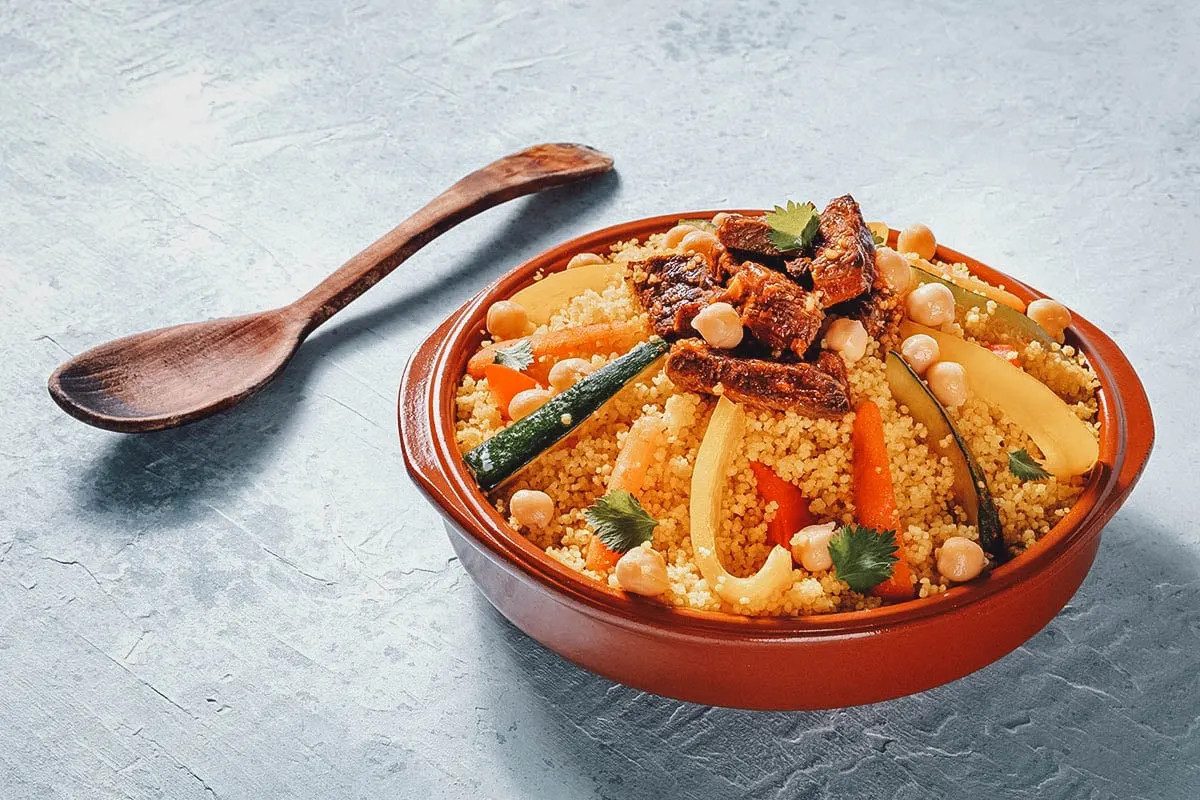
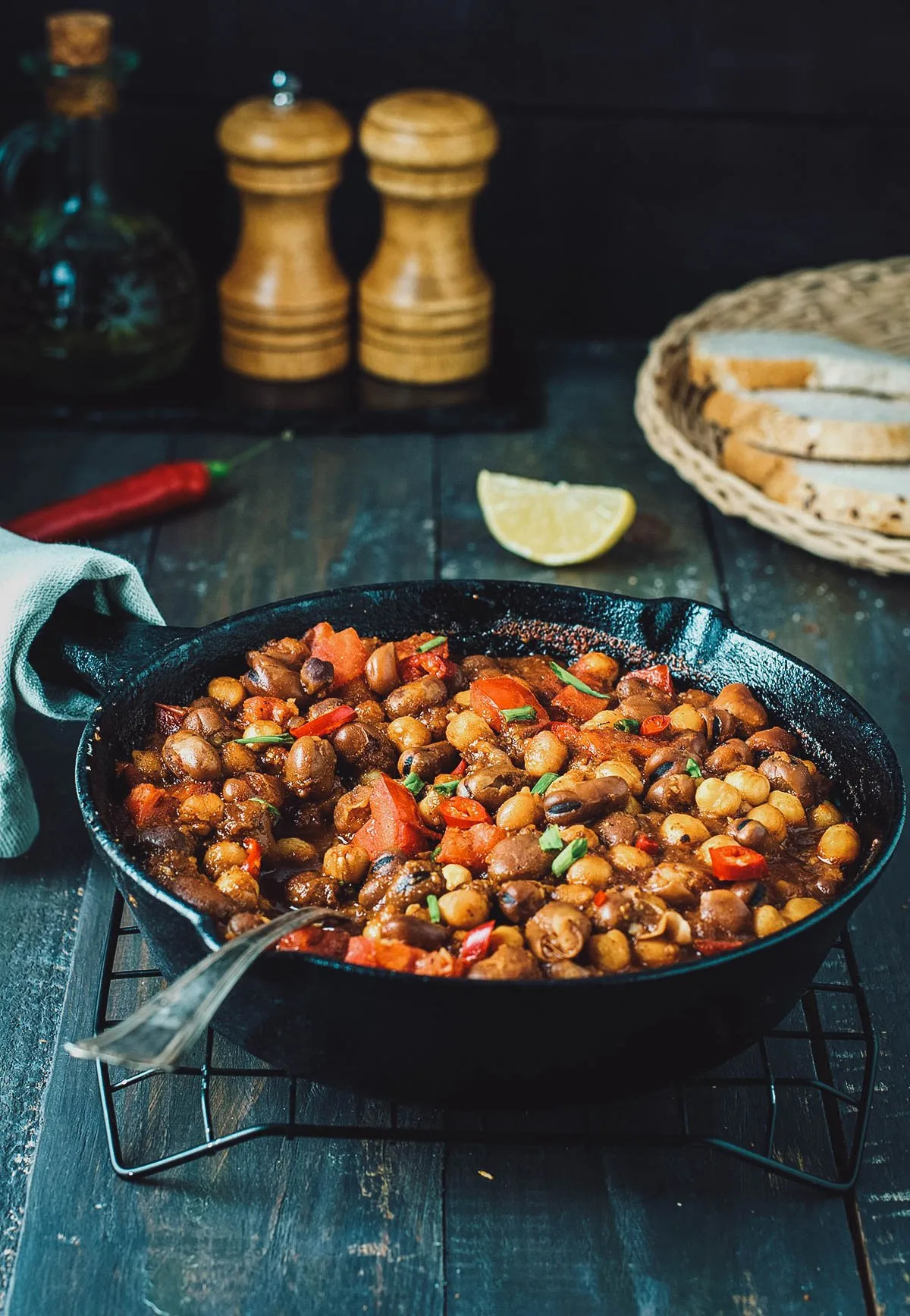
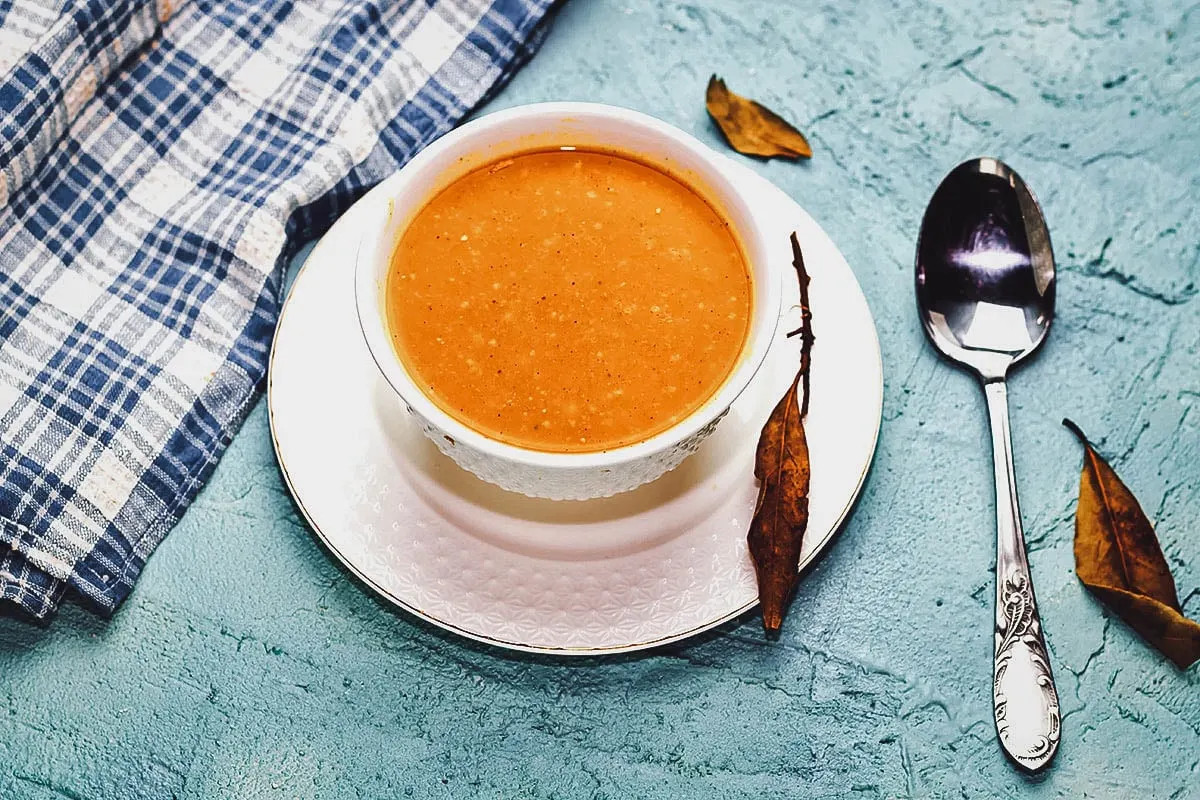
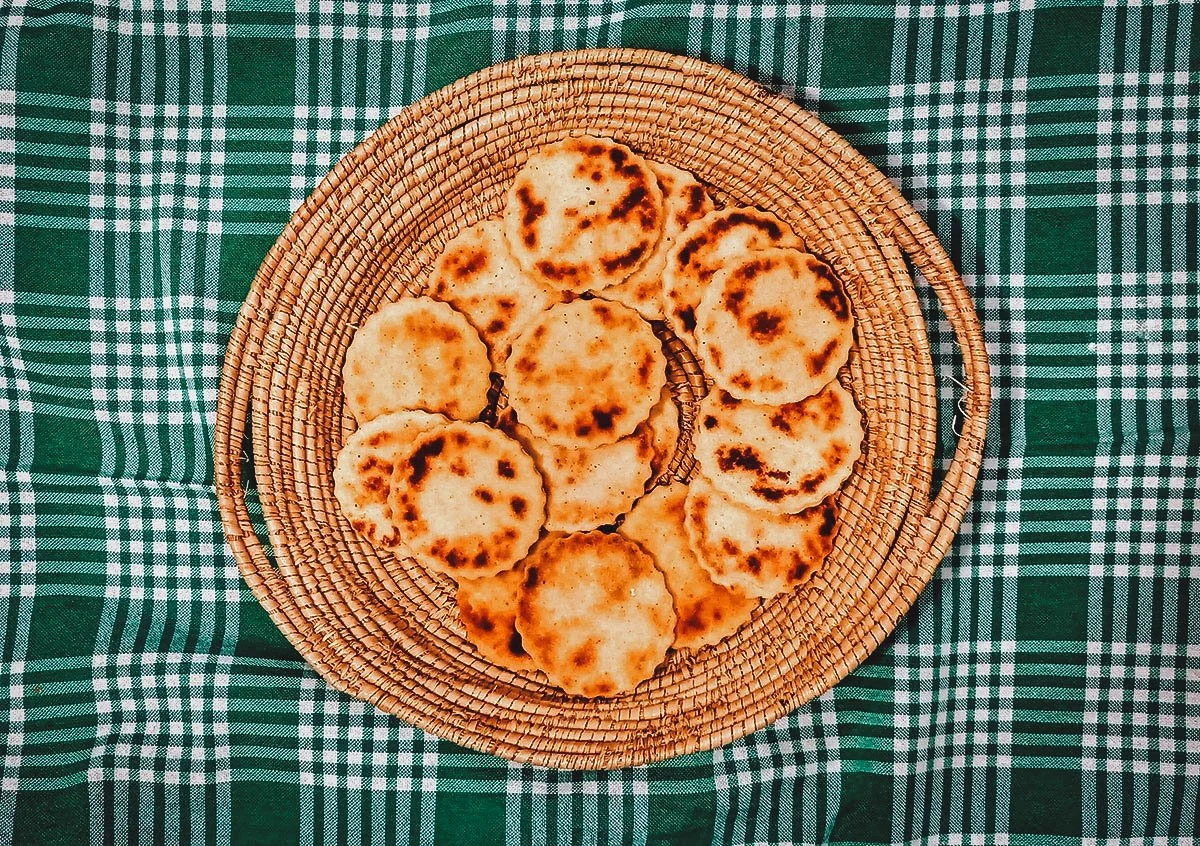
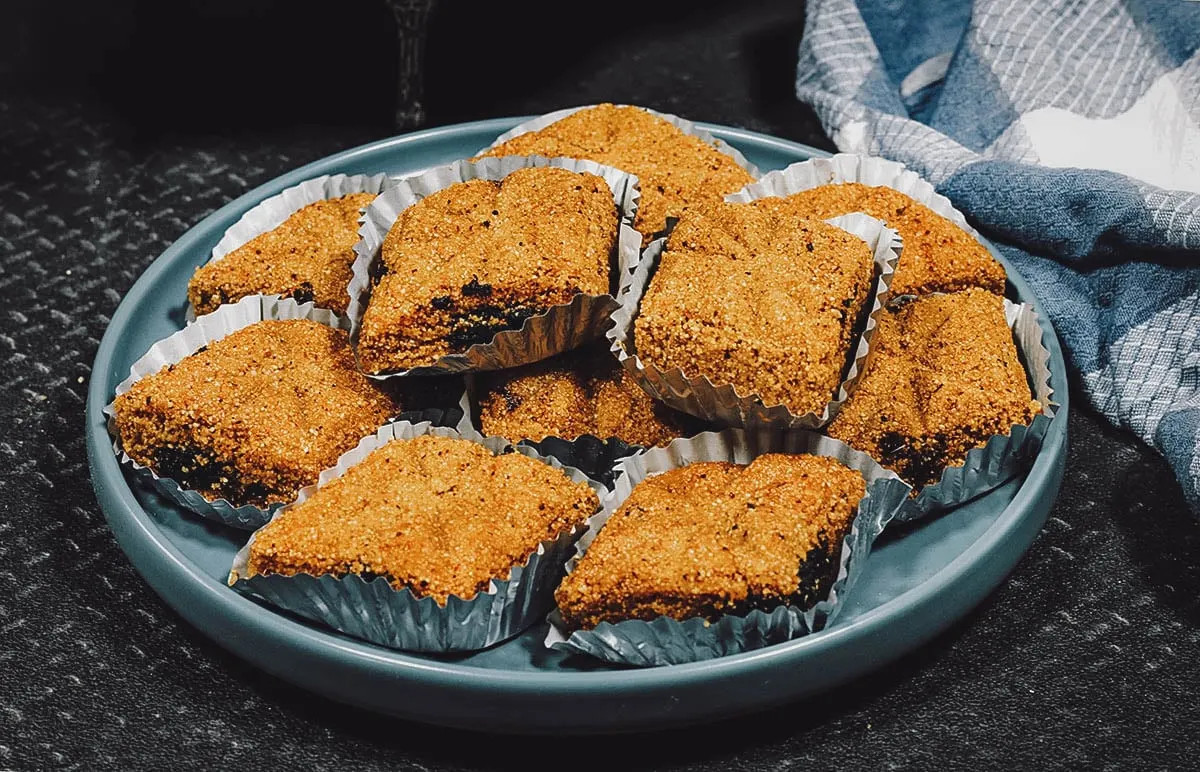
3. How Does Chakchouka Reflect Algerian Culinary Traditions?
Chakchouka, a vibrant and flavorful dish, embodies the essence of Algerian cuisine through its unique blend of ingredients and cooking techniques. It showcases the influence of various cultures while maintaining its distinctive Algerian character.
- Cultural Fusion: Chakchouka reflects the fusion of Berber, Arab, and Ottoman influences, with variations found across North Africa and the Middle East.
- Use of Local Ingredients: It utilizes readily available ingredients like tomatoes, peppers, onions, and spices, highlighting the importance of local produce in Algerian cooking.
- Versatility: Chakchouka’s adaptability, with variations including different vegetables and meats, demonstrates the flexibility and creativity inherent in Algerian cuisine.
According to a study by the University of Algiers in 2020, chakchouka is a staple in Algerian households, often prepared for breakfast, lunch, or dinner. The study highlights its nutritional value and its role as a symbol of Algerian culinary identity.
4. Why Is Couscous Considered the National Dish of Algeria?
Couscous holds the esteemed title of Algeria’s national dish due to its historical significance, cultural importance, and widespread popularity. It represents the heart of Algerian cuisine and is deeply ingrained in the country’s culinary identity.
- Historical Significance: Couscous has been a staple food in North Africa for centuries, with evidence suggesting its origins date back to the Berber kingdoms.
- Cultural Importance: It is a central dish in Algerian celebrations, family gatherings, and everyday meals, symbolizing hospitality and togetherness.
- Versatility: Couscous can be prepared in countless ways, with different regions and families boasting their own unique recipes and variations.
UNESCO recognizes couscous as an intangible cultural heritage, emphasizing its importance not only in Algeria but across the Maghreb region. This recognition highlights its role in preserving cultural traditions and promoting culinary diversity.
5. What Makes Rechta a Special-Occasion Dish in Algeria?
Rechta, a delicate pasta dish, is reserved for special occasions in Algeria due to its intricate preparation, symbolic significance, and association with joyous celebrations. It is a dish that embodies the spirit of Algerian hospitality and culinary artistry.
- Intricate Preparation: Making rechta requires time and skill, with many Algerian households preparing the thin noodles from scratch.
- Symbolic Significance: Rechta is often served during Eid al Fitr and Mouloud, marking the end of Ramadan and celebrating the prophet Muhammad’s birth, respectively.
- Celebratory Association: The dish’s rich flavors and festive presentation make it a fitting centerpiece for special gatherings, symbolizing abundance and joy.
According to Algerian culinary historian Fatima-Zohra, rechta is more than just a dish; it is a symbol of Algerian cultural identity and a testament to the country’s rich culinary heritage.
6. How Does Dobara Reflect the Regional Cuisine of Biskra?
Dobara, a spicy vegetable stew, is a culinary emblem of Biskra, a region in Northeastern Algeria known for its unique desert climate and agricultural practices. The dish reflects the region’s resourcefulness, culinary traditions, and adaptation to its harsh environment.
- Use of Local Produce: Dobara features chickpeas or fava beans, both of which thrive in Biskra’s arid climate, highlighting the region’s agricultural adaptations.
- Spicy Flavors: The dish’s bold flavors, derived from spices and chili peppers, reflect the region’s preference for robust and warming cuisine.
- Hearty and Filling: Dobara’s hearty nature makes it a staple during the colder months, providing sustenance and warmth in the desert environment.
The dish’s origins in Biskra showcase the diversity of Algerian cuisine, with each region contributing its own unique flavors and culinary traditions.
7. What Makes Berkoukes a Comforting Soup During Cold Months?
Berkoukes, a hearty soup featuring large couscous balls, is a quintessential comfort food in Algeria, particularly during the colder months. Its warmth, rich flavors, and satisfying texture make it a beloved staple in Algerian households.
- Warming Qualities: The soup’s spicy tomato broth and hearty ingredients provide warmth and comfort during chilly weather.
- Satisfying Texture: The large couscous balls add a unique texture that is both comforting and satisfying.
- Nutritional Value: Berkoukes is packed with nutrients from vegetables, meat (optional), and couscous, providing essential vitamins and minerals.
According to a survey conducted by the Algerian Ministry of Health in 2019, berkoukes is frequently consumed during winter months due to its perceived health benefits and warming properties.
8. Why Is Chorba Frik a Popular Dish During Ramadan?
Chorba Frik, a tomato-based soup made with crushed green wheat, is a staple during Ramadan in Algeria due to its nutritional value, ease of digestion, and cultural significance. It is a dish that nourishes both body and soul during the holy month.
- Nutritional Value: Frik is a good source of fiber and nutrients, providing sustained energy during the long hours of fasting.
- Ease of Digestion: The soup is easy on the stomach, making it an ideal choice for breaking the fast after a day of abstinence.
- Cultural Significance: Chorba Frik is a traditional dish passed down through generations, representing family, community, and the spirit of Ramadan.
Its presence on the Ramadan table signifies the importance of tradition and the sharing of a communal meal during this sacred time.
9. How Does Harira Differ from Other Tomato-Based Soups in Algeria?
Harira, a smooth and creamy tomato soup, distinguishes itself from other Algerian tomato-based soups through its unique texture, flavor profile, and specific ingredients. It is a dish that showcases Algerian culinary finesse and attention to detail.
- Smooth and Creamy Texture: Harira’s smooth texture sets it apart, achieved through careful blending and simmering of ingredients.
- Unique Flavor Profile: The soup’s distinct flavor comes from a blend of spices, herbs, and often a touch of lemon juice, creating a harmonious balance of savory and tangy notes.
- Specific Ingredients: Unlike some other tomato soups, harira often includes ingredients like lamb, beef, or chicken, as well as optional additions like frik or vermicelli.
While sharing a base of tomatoes, harira’s specific preparation and ingredients create a unique culinary experience.
10. What Makes Mechoui a Special-Occasion Feast in Algeria?
Mechoui, a spit-roasted lamb seasoned with ras el hanout, is a centerpiece of Algerian feasts due to its impressive presentation, rich flavors, and association with celebration and generosity. It is a dish that embodies Algerian hospitality and culinary pride.
- Impressive Presentation: The sight of a whole lamb roasting over an open fire is a spectacle that signifies abundance and celebration.
- Rich Flavors: The lamb is infused with the aromatic spices of ras el hanout, creating a complex and deeply satisfying flavor profile.
- Association with Celebration and Generosity: Mechoui is typically served at weddings, Eid celebrations, and other special occasions, symbolizing generosity and the sharing of a communal meal.
The dish’s significance extends beyond its taste, representing a cultural tradition of feasting and celebration.
11. What Are the Different Ways Msemen Can Be Enjoyed in Algeria?
Msemen, a flatbread pancake, offers a versatile culinary experience in Algeria, enjoyed in various ways for breakfast, snacks, or even as a light meal. Its adaptability and simple yet satisfying flavors make it a beloved staple in Algerian cuisine.
- Breakfast: Msemen is often enjoyed for breakfast with butter, honey, and a cup of coffee or mint tea.
- Snack: It can be eaten as a snack throughout the day, either plain or with a variety of fillings.
- Light Meal: Msemen can be served as a light meal with savory fillings like cheese, vegetables, or meat.
The possibilities are endless, with each Algerian household adding its own personal touch to this versatile dish.
12. How Does Kesra Complement Other Algerian Dishes?
Kesra, a round flatbread, plays a crucial role in Algerian cuisine as a versatile accompaniment to a variety of dishes, providing a neutral base that complements and enhances the flavors of stews, soups, and other main courses.
- Versatile Accompaniment: Kesra is served with a wide range of Algerian dishes, from harira and chorba frik to tagines and stews.
- Neutral Base: Its simple flavor allows it to complement the complex flavors of other dishes without overpowering them.
- Essential Part of the Meal: Kesra is often used to scoop up sauces and stews, making it an essential part of the Algerian dining experience.
The simplicity of kesra belies its importance in the overall Algerian culinary landscape.
13. What Makes Bourek a Popular Ramadan Appetizer?
Bourek, a savory pastry filled with ground beef, onions, cheese, and spices, is a popular appetizer during Ramadan in Algeria due to its delicious flavors, satisfying texture, and ease of preparation.
- Delicious Flavors: The combination of ground beef, onions, cheese, and spices creates a savory and satisfying flavor profile.
- Satisfying Texture: The crispy pastry and the savory filling provide a delightful textural contrast.
- Ease of Preparation: Bourek can be prepared ahead of time and easily fried or baked just before serving, making it a convenient option for Ramadan meals.
Its presence on the Ramadan table symbolizes the breaking of the fast and the sharing of a delicious meal with family and friends.
14. How Does Samsa Represent Algerian Pastry Traditions?
Samsa, triangle-shaped pastries filled with almonds, sugar, and orange blossom water, embodies Algerian pastry traditions through its delicate flavors, intricate preparation, and association with celebrations and special occasions.
- Delicate Flavors: The combination of almonds, sugar, and orange blossom water creates a delicate and fragrant flavor profile.
- Intricate Preparation: Making samsa requires skill and patience, with each pastry carefully shaped and fried to golden perfection.
- Association with Celebrations and Special Occasions: Samsa is often served during Eid al Fitr and other special events, symbolizing joy and celebration.
The pastry’s delicate flavors and intricate preparation reflect the artistry and dedication that characterize Algerian pastry traditions.
15. What Is the Significance of Tcharek at Algerian Weddings?
Tcharek, crescent-shaped cookies, holds a special significance at Algerian weddings, symbolizing good luck, fertility, and the sweetness of marriage. Its presence at these celebrations reflects the importance of tradition and the sharing of joy with loved ones.
- Symbolism: The crescent shape is often associated with good luck and new beginnings, while the sweetness of the cookie represents the sweetness of marriage.
- Tradition: Tcharek is a traditional wedding pastry passed down through generations, representing the continuity of cultural customs.
- Sharing of Joy: Serving tcharek at weddings is a way to share the joy of the occasion with family and friends, symbolizing the couple’s happiness and the community’s support.
The cookie’s presence at Algerian weddings signifies the importance of tradition, symbolism, and the sharing of joy with loved ones.
16. What Makes Makroudh a Popular Dessert During Eid al Fitr?
Makroudh, diamond-shaped pastries filled with dates or almonds and soaked in honey, is a beloved dessert during Eid al Fitr in Algeria due to its rich flavors, festive presentation, and association with the celebration of the end of Ramadan.
- Rich Flavors: The combination of dates or almonds, semolina, and honey creates a rich and satisfying flavor profile.
- Festive Presentation: The diamond shape and the glistening honey coating make makroudh a visually appealing dessert, fitting for a festive occasion.
- Association with Eid al Fitr: Makroudh is traditionally served during Eid al Fitr, symbolizing the sweetness of the celebration and the joy of breaking the fast.
Its presence on the Eid al Fitr table signifies the importance of tradition, celebration, and the sharing of a delicious meal with family and friends.
17. How Does Griwech Showcase Algerian Pastry Artistry?
Griwech, a deep-fried pastry formed into various shapes and drizzled with honey, showcases Algerian pastry artistry through its intricate designs, crispy texture, and delicate flavors. It is a testament to the creativity and skill of Algerian pastry chefs.
- Intricate Designs: Griwech is often formed into elaborate shapes, such as roses, bows, or braided pretzels, showcasing the pastry chef’s artistic skills.
- Crispy Texture: The deep-frying process creates a crispy and delicate texture that is both satisfying and delightful.
- Delicate Flavors: The honey or caramel drizzle adds a touch of sweetness and enhances the pastry’s overall flavor profile.
Its intricate designs, crispy texture, and delicate flavors make it a true masterpiece of Algerian pastry artistry.
18. What Are Some Common Ingredients Used in Algerian Cooking?
Algerian cuisine relies on a variety of fresh, flavorful ingredients that contribute to its unique and diverse flavors. Here are some common ingredients that are frequently used in Algerian cooking:
- Mutton and Poultry: These are staple meats used in many traditional dishes.
- Vegetables: Tomatoes, onions, peppers, zucchini, and potatoes are frequently used in stews, soups, and side dishes.
- Dried Fruits: Dates, figs, and raisins add sweetness and texture to various dishes.
- Spices: Cumin, paprika, cinnamon, ginger, and ras el hanout are essential for flavoring Algerian cuisine.
- Semolina: Used to make couscous and various types of bread and pastries.
- Olive Oil: A staple cooking oil used in many Algerian dishes.
- Legumes: Chickpeas and fava beans are commonly used in stews and soups.
- Herbs: Fresh herbs like parsley, cilantro, and mint add flavor and aroma to Algerian dishes.
19. Are There Vegetarian Options in Algerian Cuisine?
Yes, while Algerian cuisine often features meat, there are several delicious and satisfying vegetarian options available. Here are a few examples:
- Chakchouka: This vegetable stew is typically vegetarian and can be customized with various vegetables.
- Dobara: This spicy vegetable stew made with chickpeas or fava beans is a hearty and flavorful vegetarian option.
- Couscous: While often served with meat, couscous can also be enjoyed with a variety of vegetable-based stews.
- Msemen: This flatbread pancake can be enjoyed with sweet or savory fillings, including vegetarian options like cheese or vegetables.
- Vegetable Tagines: Tagines are slow-cooked stews that can be made with a variety of vegetables and spices, offering a flavorful and aromatic vegetarian meal.
20. How Can I Recreate Authentic Algerian Flavors at Home?
Recreating authentic Algerian flavors at home is easier than you might think. Here are a few tips to help you embark on your culinary journey:
- Source Authentic Ingredients: Look for authentic Algerian spices, semolina, and other ingredients at specialty stores or online.
- Follow Traditional Recipes: Use authentic Algerian recipes as a guide, but don’t be afraid to experiment and adjust the flavors to your liking.
- Embrace Spices: Algerian cuisine is known for its bold and aromatic spices. Don’t be afraid to use them generously to achieve authentic flavors.
- Use Fresh Herbs: Fresh herbs like parsley, cilantro, and mint add brightness and aroma to Algerian dishes.
- Be Patient: Many Algerian dishes require slow cooking to develop their full flavor. Be patient and allow the flavors to meld together over time.
At larosafoods.com, you’ll find a wealth of authentic Algerian recipes, cooking tips, and ingredient guides to help you recreate the flavors of Algeria in your own kitchen. We provide detailed instructions, nutritional information, and helpful tips to ensure your culinary creations are both delicious and authentic.
21. Where Can I Find Authentic Algerian Recipes and Cooking Tips?
Finding authentic Algerian recipes and cooking tips is now easier than ever, thanks to a wealth of online resources and culinary communities. Here are a few places to explore:
- larosafoods.com: Our website offers a comprehensive collection of authentic Algerian recipes, cooking tips, and ingredient guides.
- Algerian Food Blogs and Websites: Many Algerian food bloggers and websites share traditional recipes and cooking techniques.
- Culinary Communities and Forums: Online culinary communities and forums are great places to connect with other food enthusiasts and share recipes and tips.
- Cookbooks: Explore cookbooks dedicated to Algerian cuisine for a curated collection of traditional recipes.
22. What Are the Nutritional Benefits of Algerian Food?
Algerian cuisine offers a variety of nutritional benefits, thanks to its emphasis on fresh ingredients, whole grains, and lean proteins. Here are some of the key nutritional advantages of Algerian food:
- Rich in Vitamins and Minerals: Algerian dishes often include a variety of vegetables, fruits, and herbs, providing essential vitamins and minerals.
- Good Source of Fiber: Couscous, legumes, and vegetables contribute to a high fiber content, promoting digestive health.
- Lean Protein Sources: Mutton and poultry are often used in moderation, providing lean protein sources.
- Healthy Fats: Olive oil is a staple ingredient, providing healthy monounsaturated fats.
- Antioxidant Properties: Spices and herbs like cumin, paprika, and cinnamon are rich in antioxidants, which can help protect against cell damage.
23. How Has Algerian Cuisine Evolved Over Time?
Algerian cuisine has undergone a fascinating evolution over time, shaped by a confluence of historical events, cultural exchanges, and culinary innovations. Here are some key milestones in its evolution:
- Ancient Berber Roots: The cuisine’s foundations lie in the culinary traditions of the Berber people, who utilized local ingredients and simple cooking techniques.
- Arab Influence: The arrival of the Arabs in the 7th century brought new ingredients, spices, and cooking styles, enriching the Algerian culinary landscape.
- Ottoman Empire: The Ottoman Empire’s rule introduced dishes like bourek and chorba frik, further diversifying Algerian cuisine.
- French Colonial Era: The French colonial era had a significant impact, with the introduction of new ingredients and cooking techniques.
- Modern Era: Today, Algerian cuisine continues to evolve, with chefs and home cooks experimenting with new flavors and techniques while preserving traditional recipes.
24. What Role Does Food Play in Algerian Culture and Society?
Food plays a central role in Algerian culture and society, serving as a means of communication, celebration, and cultural expression. It is deeply intertwined with Algerian values and traditions.
- Social Gatherings: Food is an integral part of social gatherings, with meals often shared among family and friends.
- Hospitality: Offering food is a sign of hospitality and generosity in Algerian culture.
- Celebrations: Special occasions and holidays are often marked with elaborate meals and traditional dishes.
- Cultural Identity: Food serves as a symbol of Algerian cultural identity, with traditional dishes passed down through generations.
25. What Are Some Tips for Adapting Algerian Recipes to Different Dietary Needs?
Adapting Algerian recipes to different dietary needs is possible with a few simple modifications. Here are some tips for catering to various dietary restrictions:
- Vegetarian/Vegan: Replace meat with plant-based protein sources like lentils, chickpeas, or tofu.
- Gluten-Free: Use gluten-free flour blends or alternative grains like quinoa or rice in place of semolina or wheat flour.
- Low-Carb: Reduce the amount of couscous or bread served with meals and focus on vegetable-based dishes.
- Low-Sodium: Use low-sodium broth and reduce the amount of salt used in recipes.
- Dairy-Free: Substitute dairy products with plant-based alternatives like almond milk or coconut cream.
Remember to consult with a healthcare professional or registered dietitian for personalized dietary advice.
26. How Can I Learn More About the History and Cultural Significance of Algerian Cuisine?
Learning more about the history and cultural significance of Algerian cuisine can be a rewarding and enriching experience. Here are some resources to explore:
- Books: Look for books on Algerian history, culture, and cuisine.
- Documentaries: Watch documentaries that explore Algerian culture and culinary traditions.
- Museums: Visit museums that showcase Algerian art, history, and culture.
- Cultural Centers: Attend events and workshops at Algerian cultural centers.
- Online Resources: Explore online resources like academic articles, cultural websites, and culinary blogs.
27. What Are Some Regional Variations in Algerian Cuisine?
Algerian cuisine is diverse and varied, with each region boasting its own unique culinary specialties and traditions. Here are some examples of regional variations:
- Algiers: Known for rechta, a special-occasion pasta dish.
- Biskra: Famous for dobara, a spicy vegetable stew.
- Oran: Known for dishes influenced by Spanish cuisine, such as paella.
- Constantine: Known for its hearty stews and use of spices.
- The Sahara: Features dishes adapted to the desert climate, such as couscous with dried fruits and nuts.
28. How Can I Plan a Trip to Algeria to Experience Its Culinary Delights?
Planning a trip to Algeria to experience its culinary delights can be an unforgettable adventure. Here are some tips to help you plan your trip:
- Research: Research the different regions of Algeria and their culinary specialties.
- Plan Your Itinerary: Plan your itinerary to include visits to local markets, restaurants, and cooking schools.
- Book Accommodation: Book accommodation in advance, especially during peak season.
- Learn Basic Arabic Phrases: Learning a few basic Arabic phrases will enhance your interactions with locals.
- Be Open to New Experiences: Be open to trying new foods and embracing the local culture.
- Consider a Guided Tour: Consider joining a guided tour that focuses on Algerian cuisine.
29. What Are Some Common Misconceptions About Algerian Food?
There are several common misconceptions about Algerian food that can prevent people from fully appreciating its diversity and complexity. Here are a few examples:
- It’s All Spicy: While some Algerian dishes are spicy, many others are mild and flavorful.
- It’s Only Meat-Based: While meat is often used in Algerian cuisine, there are many delicious vegetarian options available.
- It’s The Same as Moroccan Food: While there are similarities between Algerian and Moroccan cuisine, each has its own unique flavors and traditions.
- It’s Difficult to Cook at Home: With the right recipes and ingredients, Algerian food is easy to cook at home.
30. How Does larosafoods.com Enhance My Understanding and Appreciation of Algerian Food?
larosafoods.com serves as your ultimate guide to understanding and appreciating Algerian food. We provide:
- Authentic Recipes: A comprehensive collection of authentic Algerian recipes, tested and perfected for home cooks.
- Cooking Tips: Expert cooking tips and techniques to help you recreate the flavors of Algeria in your own kitchen.
- Ingredient Guides: Detailed information about common Algerian ingredients, including where to find them and how to use them.
- Cultural Insights: Articles and resources that explore the history, culture, and traditions behind Algerian cuisine.
- Nutritional Information: Detailed nutritional information for each recipe, allowing you to make informed choices about your diet.
- Community Forum: A community forum where you can connect with other food enthusiasts, share recipes, and ask questions.
With larosafoods.com, you can embark on a culinary journey to Algeria without ever leaving your home.
Ready to explore the vibrant world of Algerian food? Visit larosafoods.com today for authentic recipes, cooking tips, and cultural insights. Discover the flavors of North Africa and embark on a culinary adventure that will tantalize your taste buds and broaden your culinary horizons.
Address: 1 S Park St, San Francisco, CA 94107, United States
Phone: +1 (415) 987-0123
Website: larosafoods.com

